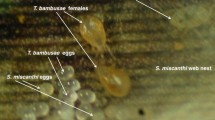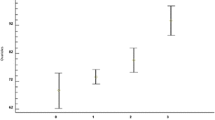Abstract
To analyze the relationship between female body size and lifetime fecundity (LF) in Monochamus urussovii (Fischer), 17 pairs of adults were reared on Picea jezoensis (Sieb. et Zucc.) Carrière twig sections and were allowed to oviposit on Abies sachalinensis (Fr. Schmidt) Masters bolts at 25 °C and 16:8 h light:dark. The means of life span and LF were 42.5 days and 28.2 eggs for fertile and sterile females combined, respectively. The mean lengths of preoviposition and oviposition periods (OPs) of fertile females were 12.1 and 28.1 days, respectively. The potential fecundity was estimated to be 72.1. Path analysis showed that female body size, i.e., mass and elytral length, had positive effects on LF through the oviposition rate but not through the OP. Ovariole number was 24 and did not vary according to body size, indicating a higher egg productivity per ovariole in large females than in small ones. Higher egg productivity per ovariole in large females is true for each of three other synovigenic lamiine beetles with an almost fixed number of ovarioles. The body size-dependent egg productivity per ovariole is considered to be one of the reasons for the body size–LF correlation in synovigenic species with a fixed ovariole number.





Similar content being viewed by others
References
Akbulut S (2009) Comparison of the reproductive potential of Monochamus galloprovincialis Olivier (Coleoptera:Cerambycidae) on two pine species under laboratory conditions. Phytoparasitica 37:125–135
Akbulut S, Linit MJ (1999a) Reproductive potential of Monochamus carolinensis (Coleoptera: Cerambycidae) with respect to pinewood nematode phoresis. Environ Entomol 28:407–411
Akbulut S, Linit MJ (1999b) Flight performance of Monochamus carolinensis (Coleoptera: Cerambycidae) with respect to nematode phoresis and beetle characteristics. Environ Entomol 28:1014–1020
Akutsu K (1985) Studies on biology and control of udo longicorn beetle (Acalolepta luxuriosa Bates). Bull Tokyo Metropolitan Agric Exp Stn 18:1–72 (in Japanese with English summary)
Bennettova B, Fraenkel G (1981) What determines the number of ovarioles in a fly ovary? J Insect Physiol 27:403–410
Branquart E, Hemptinne JL (2000) Development of ovaries, allometry of reproductive traits and fecundity of Episyrphus balteatus (Diptera: Syrphidae). Eur J Entomol 97:165–170
Cohet Y, David JR (1978) Control of adult reproductive potential by pre-imaginal thermal conditions—study in Drosophila melanogaster. Oecologia 36:295–306
Collins NC (1980) Developmental responses to food limitation as indicators of environmental conditions for Ephydra cinerea Jones (Diptera). Ecology 61:650–661
Dixon AFG, Guo Y (1993) Egg and cluster size in ladybird beetles (Coleoptera: Coccinellidae): the direct and indirect effects of aphid abundance. Eur J Entomol 90:457–463
Eliopoulos PA, Harvey JA, Athanassiou CG, Stathas GJ (2003) Effect of biotic and abiotic factors on reproductive parameters of the synovigenic endoparasitoid Venturia canescens. Physiol Entomol 28:268–275
García-Barros E (2000) Body size, egg size, and their interspecific relationships with ecological and life history traits in butterflies (Lepidoptera: Papilionoidea, Hesperioidea). Biol J Linn Soc 70:251–284
Haack RA, Slansky F (1987) Nutritional ecology of wood-feeding Coleoptera, Lepidoptera, and Hymenoptera. In: Slansky F, Rodriguez JG (eds) Nutritional ecology of insects, mites, spiders, and related invertebrates. Wiley, New York, pp 449–486
Hellrigl KG (1971) Die Bionomie der europäischen Monochamus-Arten (Coleopt., Cerambycid.) und ihre Bedeutung für die Forst- und Holzwirtschaft. Redia Ser 3 52:367–509
Hodin J (2009) She shapes events as they come: plasticity in female insect reproduction. In: Whitman DW, Ananthakrishnan TN (eds) Phenotypic plasticity of insects: mechanism and consequences. Science Publishers, Enfield, pp 423–520
Honěk A (1993) Intraspecific variation in body size and fecundity in insects: a general relationship. Oikos 66:483–492
Humphry SJ, Linit MJ (1989) Tethered flight of Monochamus carolinensis (Coleoptera: Cerambycidae) with respect to beetle age and sex. Environ Entomol 18:124–126
Ito K (1982) The tethered flight of the Japanese pine sawyer, Monochamus alternatus Hope (Coleoptera: Cerambycidae). J Jpn For Soc 64:395–397
Jervis MA, Ferns PN (2004) The timing of egg maturation in insects: ovigeny index and initial egg load as measures of fitness and of resource allocation. Oikos 107:449–460
Jikumaru S, Togashi K, Taketsune A, Takahashi F (1994) Oviposition biology of Monochamus saltuarius (Coleoptera: Cerambycidae) at a constant temperature. Appl Entomol Zool 29:555–561
Kasuga H, Togashi K (2012) Nine-month persistence of Bursaphelenchus xylophilus in living Abies sachalinensis and Picea jezoensis seedlings and nematode reproduction in stem sections. Nematology 14:547–554
Katsuyama N, Sakurai H, Tabata K, Takeda S (1989) Effect of age of post-feeding twig on the ovarian development of Japanese pine sawyer, Monochamus altermatus (Coleoptera: Cerambycidae). Res Bull Fac Agric Gifu Univ 54:81–89 (in Japanese)
Koizumi C (1994) Monochamus urussovii. In: Kobayashi F, Taketani A (eds) Forest insects. Yokendo, Tokyo, pp 179–180 (in Japanese)
Kojima K, Nakamura S (2011) Food plants of cerambycid beetles (Cerambycidae, Coleoptera) in Japan (revised and enlarged edition). Hiba Society of Natural History, Shobara (in Japanese)
Kuboki M (2015) Diversity in life manner and ovary development of the subfamily Lepturinae and the genus Pidonia. In: Iwabuchi K (ed) Science watch: biology of cerambycid beetles. Hokuryukan, Tokyo, pp 304–337 (in Japanese)
Leather SR (1988) Size, reproductive potential and fecundity in insects: things are not as simple as they seem. Oikos 51:386–389
Mamiya Y (1983) Pathology of the pine wilt disease caused by Bursaphelenchus xylophilus. Ann Rev Phytopathol 21:201–220
Mamiya Y (1988) History of pine wilt disease in Japan. J Nematol 20:219–226
Mamiya Y, Enda N (1979) Bursaphelenchus mucronatus n. sp. (Nematoda: Aphelenchoididae) from pine wood and its biology and pathogenicity to pine trees. Nematologica 25:353–361
Nakayama Y, Jikumaru S, Togashi K (1998) Reproductive traits and diel activity of adult Monochamus saltuarius (Coleoptera: Cerambycidae) at two different temperatures. J For Res 3:61–65
Naves P, de Sousa E, Quartau JA (2006) Reproductive traits of Monochamus galloprovincialis (Coleoptera: Cerambycidae) under laboratory conditions. Bull Entomol Res 96:289–294
Rhainds M (2015) Size-dependent realized fecundity in two lepidopteran capital breeders. Environ Entomol 44:1193–1200
Rosenheim JA, Heimpel GE, Mangel M (2000) Egg maturation, egg resorption and the costliness of transient egg limitation in insects. Proc R Soc Lond B 267:1565–1573
Rosetti N, Remis MI (2015) Phenotypic variation and sexual size dimorphism in Dichroplus elongates (Orthoptera: Acrididae). Environ Entomol 44:1240–1249
Stewart AL, Hemptinne JL, Dixon AFG (1991) Reproductive tactics of ladybird beetles-relationships between egg size, ovariole number and developmental time. Func Ecol 5:380–385
Strong DR, Lawton JH, Southwood R (1984) Insects on plants. Blackwell, Oxford
Sumioka H, Kuroda S, Yoshitake N (1982) Feed efficiency and expression of several characters of the silkworm, Bombyx mori, under the restricted feeding. J Seric Sci Jpn 51:415–419 (in Japanese with English summary)
Tares S, Abad P, Bruguier N, de Guiran G (1992) Identification and evidence for relationships among geographical isolates of Bursaphelenchus spp. (pinewood nematode) using homologous DNA probes. Heredity 68:157–164
Togashi K (1990) Change in the activity of adult Monochamus alternatus Hope (Coleoptera: Cerambycidae) in relation to age. Appl Entomol Zool 25:153–159
Togashi K (1997) Lifetime fecundity and body size of Monochamus alternatus (Coleoptera: Cerambycidae) at a constant temperature. Jpn J Entomol 65:458–470
Togashi K (2007) Lifetime fecundity and female body size in Paraglenea fortunei (Coleoptera: Cerambycidae). Appl Entomol Zool 42:549–556
Togashi K, Itabashi M (2005) Maternal size dependency of ovariole number in Dastarcus helophoroides (Coleoptera: Colydiidae). J For Res 10:373–376
Togashi K, Taga Y, Iguchi K, Aikawa T (2008) Bursaphelenchus mucronatus (Nematoda: Aphelenchoididae) vectored by Monochamus urussovi (Coleoptera: Cerambycidae) in Hokkaido, Japan. J For Res 13:127–131
Togashi K, Kasuga H, Yamashita H, Iguchi K (2010) Larval diapause of Monochamus urussovi and photoperiodic effects on larval development in tree bolts. J Appl Entomol 134:672–674
van Vianen BA, van Lenteren JC (1986) The parasite-host relationship between Encarsia formosa Gahan (Hym., Aphelinidae) and Trialeurodes vaporariorum (Westwood) (Hom., Aleyrodidae). XIV. Genetic and environmental factors influencing body-size and number of ovarioles of Encarsia formosa. J Appl Entomol 101:321–331
Vicente C, Espada M, Vieira P, Mota M (2012) Pine wilt disease: a threat to European forestry. Eur J Plant Pathol 133:89–99
Yoon C, Shin Y-H, Yang J-O, Han J-H, Kim G-H (2011) Pinus koraiensis twigs affect Monochamus saltuarius (Coleoptera: Cerambycidae) longevity and reproduction. J Asia-Pac Entomol 14:327–333
Zhang X, Linit MJ (1998) Comparison of oviposition and longevity of Monochamus alternatus and M. carolinensis (Coleoptera: Cerambycidae) under laboratory conditions. Environ Entomol 27:885–891
Acknowledgments
The authors are grateful to Hayami Kasuga and Kazunobu Iguchi for harvesting twigs and branches of insect host trees. They also thank Dr Hiroshi Makihara for the scientific names of insect materials used in this study. This work was supported in part by Japan Society for the Promotion of Science KAKENHI grants (nos. JP18208013 and JP26292080).
Author information
Authors and Affiliations
Corresponding author
Rights and permissions
About this article
Cite this article
Togashi, K., Yamashita, H. Effects of female body size on lifetime fecundity of Monochamus urussovii (Coleoptera: Cerambycidae). Appl Entomol Zool 52, 79–87 (2017). https://doi.org/10.1007/s13355-016-0456-x
Received:
Accepted:
Published:
Issue Date:
DOI: https://doi.org/10.1007/s13355-016-0456-x




